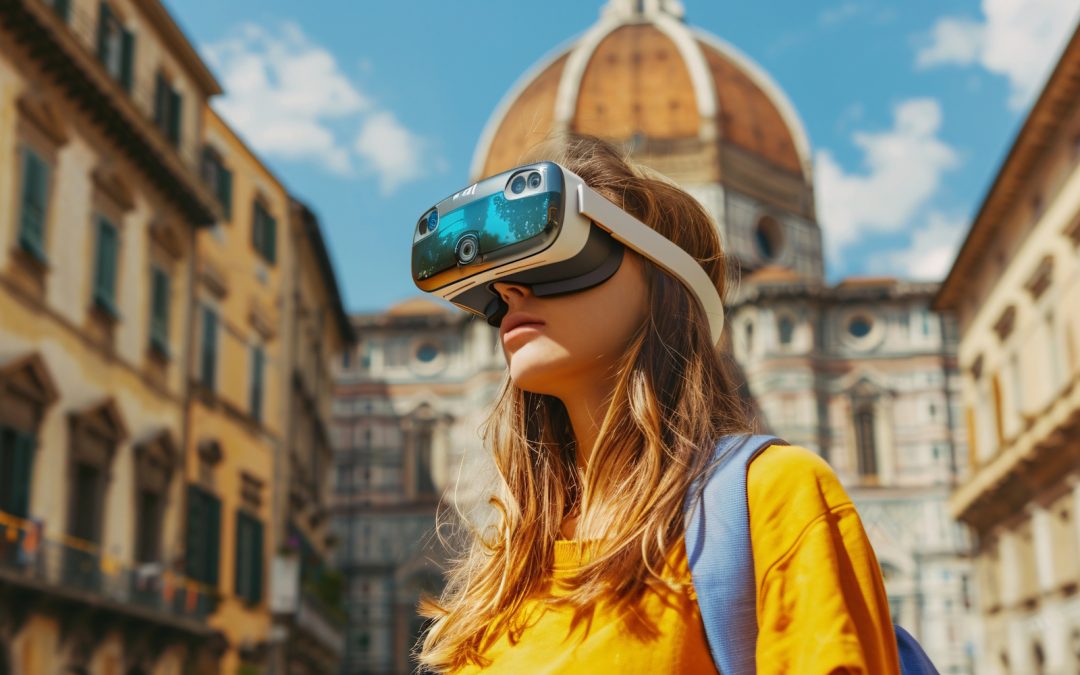The travel industry is experiencing a profound shift, with Augmented Reality (AR) and Virtual Reality (VR) technologies leading the way. These innovations are not just enhancing travel—they are fundamentally transforming how we explore the world. Whether it’s through immersive virtual tours or real-time AR guides, these technologies are making travel more interactive, personalized, and accessible.
The Rise of AR and VR in Tourism
Virtual Reality: A New Way to Explore
Virtual Reality (VR) is creating unprecedented opportunities for travelers. By offering immersive experiences, VR allows users to explore destinations virtually, providing a glimpse into the world’s most iconic sites before they even pack their bags. This technology is particularly useful for those who may be undecided about their next destination or want to explore remote locations.
Key Benefits of VR in Tourism:
- Virtual Exploration: VR enables users to virtually walk through the streets of Paris, visit the Great Wall of China, or dive into the Great Barrier Reef—all from the comfort of their homes.
- Pre-Travel Experience: VR provides a ‘try before you buy’ opportunity, helping travelers make informed decisions by experiencing the destination beforehand. This can significantly enhance customer satisfaction and reduce the likelihood of booking regret.
- Accessibility: For those unable to travel due to physical, financial, or time constraints, VR opens up a world of possibilities, allowing them to explore destinations that might otherwise be out of reach.
Examples of VR in Tourism:
- Google Earth VR: Allows users to virtually visit almost any location on the planet, offering a 3D experience that is both educational and thrilling.
- National Geographic VR: Offers immersive VR experiences that take users to some of the most remote and beautiful places on Earth.
Augmented Reality: Enhancing Real-World Travel
Augmented Reality (AR) brings the digital world into the physical, overlaying useful information onto real-world environments. Imagine walking through a historical site with AR providing live translations, detailed historical insights, and even reconstructions of ruins. AR enhances the travel experience by adding layers of interactive content that deepen your connection to the destination. (Rock Paper Reality)
Key Benefits of AR in Tourism:
- Interactive Tours: AR can turn a simple walk through a city or museum into an interactive learning experience. For instance, the Streetmuseum app from the Museum of London overlays historical images and information onto your current view, letting you see the past as you explore the city.
- Personalized Experiences: AR can tailor experiences based on your preferences, guiding you to points of interest that match your interests, whether it’s food, art, or nature.
- Real-Time Information: Need directions? Or perhaps you’re curious about the monument you’re passing by? AR apps like Google Lens can provide instant information, translations, and more, making your travel experience seamless and informative.
Wearable AR Devices
The future of AR in travel is becoming increasingly wearable. Devices like AR smart glasses are making it easier to integrate digital information seamlessly into the physical world, providing travelers with hands-free access to information and a more immersive experience.
Examples of Wearable AR:
- Vuzix Blade: These smart glasses provide real-time information, navigation, and more, directly in your field of view.
Multi-Sensory VR Experiences
Advancements in multi-sensory technology, such as haptic gloves, are enhancing the realism of VR experiences. These technologies offer sensations of touch and pressure, making virtual interactions feel incredibly real and adding a new dimension to virtual travel.
Examples of Multi-Sensory VR:
- HaptX Gloves: These gloves provide tactile feedback, making interactions in VR feel more tangible.
The Impact on the Travel Industry
AR and VR technologies are not just enhancing travel—they are revolutionizing the entire travel industry. These tools offer endless possibilities for creating more personalized, immersive, and accessible travel experiences. For businesses, this means new opportunities for marketing, customer engagement, and revenue generation. (Travel Wanderlust) (Rock Paper Reality)
Key Impacts on the Travel Industry:
- Personalization: Travelers can create customized itineraries that reflect their unique interests, making each trip more meaningful.
- Enhanced Marketing: VR and AR offer innovative ways to showcase destinations, allowing potential travelers to experience them virtually before booking.
- Accessibility: These technologies make travel experiences accessible to a wider audience, including those with physical or financial limitations.
Conclusion
The future of travel is immersive, interactive, and incredibly exciting. As AR and VR continue to evolve, they are set to transform how we explore the world, making travel more accessible, personalized, and engaging than ever before. Whether you’re planning your next adventure or simply exploring from home, AR and VR are opening up new horizons for all travelers.
Explore more about the future of travel with AR and VR by visiting ARVRTravel.com. Stay updated on the latest trends and innovations in immersive travel.
Happy traveling!

